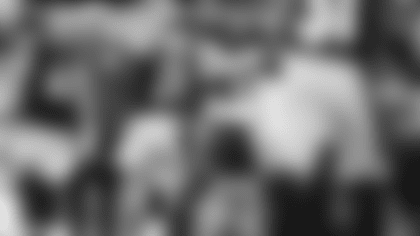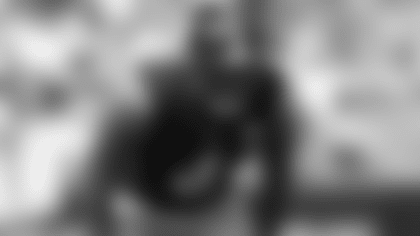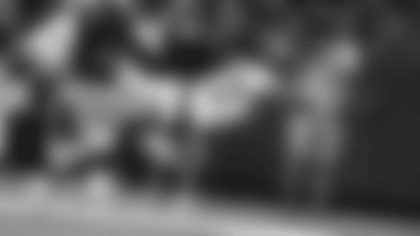Q. Last week, you talked about the challenge of defending a Raiders offense that had the 1-2 punch of the NFL's leading rusher at the time in Josh Jacobs and a dynamic playmaking receiver in Davante Adams. Jacobs finished with 44 yards on 15 carries, and Adams had 2 catches for 15 yards. Is that what you had in mind in terms of the execution of the plan, or were there other factors involved?
A. Certainly, there are other factors, but in terms of an agenda, yes, that is what we had intended. And like I mentioned, we were having discussions, because we're quite used to dealing with a 1-2 punch like that. I think back to my old Le'Veon Bell and Antonio Brown days and when you're in those significant moments in training camp-like settings in Latrobe, our mantra was always: make somebody else make the play other than those two. And that's the mindset that we took into the Raiders game, and that's why you saw Hunter Renfro making a play or two early. We just wanted to create a climate where (Jacobs and Adams) weren't the significant playmakers, and then we started moving targets around to level the playing field as the game wore on, sometimes focusing our energies on Darren Waller, sometimes focusing our energies on Hunter Renfro, but the bottom line, the base, was those two people (Jacobs and Adams) and making them play left-handed, if you will, or using supplementary guys. When you got two guys who comprise the bulk of an offense like those two, you've got to take the ball out of their hands, and it's more than just wishing 'good luck' to the guys responsible for them. I'm talking about putting schematics to it. And that's the job.
Q. Davante Adams in particular was targeted nine times and finished with just the two catches. When a receiver is targeted that many times and finished with so few catches, what has the defense done right?
A. We had two people on him. They had a commitment to getting him the ball, and thus the 9 targets, and if it's 2-on-1, the percentage is probably going to be pretty low. When they were in one-dimensional passing circumstances, and you're dealing with a guy of that stature in this game, you put two people on him. I don't know that there was a third down or a two-minute in 2014, 2015, 2016, in that area, where Antonio Brown did not have two people on him. That was just life, and that's how the game is played when you're playing at an elite level at that position.
Q. Cam Sutton's diving interception last Saturday sealed the win over the Raiders, and he's now tied-for-second on the team with 3 interceptions and leads the team with 14 passes defensed. What kind of season has he been having, and what do those statistics say about his development in what is his sixth NFL season?
A. Cam's a guy who has been on the upswing since Day Zero. He's developed within the program. He has an understanding of the totality of what it is that we do, and that is reflected in his overall play, it's reflected in the play that you mentioned. He's a Swiss Army knife. We could play him outside on first-and-10 football, we play him inside in passing circumstances and he matches up vs. high-level interior guys who are significant components of passing attacks. Tyler Boyd is a significant matchup for him on passing downs when we play Cincinnati. His versatility, his experience within our system allows us to move him and Minkah, our two primary pieces that we're able to move around quite a bit just to diversify our attack. He's a guy who has been really rock solid and really been on the rise and providing quality play for us, not only this year, but I think it's just reflective of the trajectory of his career over the 6 years he's been here.
Q. Just so I understand, what qualifies as a pass defensed?
A. Ball targeted toward a receiver and a defender doing something physically to ensure that the catch is not made. Breaking the ball up, dislodging the ball, pulling the ball out, hitting the elbow making it somewhat of an uncatchable play. It has to be some physical confrontation from a defensive back to limit the potential for a catch. It's not the closest defensive back on a drop, or the closest defensive back on an overthrow, etc. It has to be some positive action by the defensive back.
Q. Is that the key statistic in evaluating a cornerback's play?
A. I think like pass-rushers, they're evaluated by landing the plane. You can be a good defensive back by getting breakups, but you're a great one if you're catching it. It's like quarterback pressures and sacks. It tells a portion of the story, and it might speak to deficiencies. A guy who doesn't get sacks, you question his finish. Can he turn the corner? What type of body lean does he have, etc.? A defensive back with a bunch of breakups, you might question what is his hand-eye coordination like? Can he pick up the blur of the ball? Does he have poor hand selection? There are lot of things that encompass a guy not catching the ball fluidly, and so it could speak to productivity, but it also could lead to other areas of focus or needed improvement.
Q. The Ravens won the earlier matchup, and they did it in Pittsburgh by rushing for 215 yards and killing the final two-plus minutes of a 2-point game by running the football. Afterward, you said the Ravens won the attrition game, and you also said that in football, "The ball snaps, you kick butt, or you get your butt kicked." Is your team looking for payback tonight in that area, or can looking for payback be counterproductive in securing victory?
A. It can be counterproductive. It can be productive. What you'd like to think when you have a professional football team is that low-hanging fruit is there, but it's not significant in terms of our focus and what has to happen in the stadium. There's a lot of things relative to this game, and what's at stake right now for us and the team that we're playing. Certainly that exists, but that's just history. I'm in the here-and-now, and our group's in the here-and-now. They better be focused on what makes today a big day, as opposed to what transpired the last time we played them. They could use that low-hanging fruit, because the last couple of times we've been in Baltimore, we've won. But the bottom line is, that ball is gonna snap today and both teams have got to play football.
Q. What is the process for a defense when it is faced with having to account for a running quarterback?
A. The ability to run is just a component of it. I think the thing that makes Baltimore challenging and makes the discussion complex are the designed quarterback runs. Scrambling quarterbacks, you just respect that. There are certain mechanisms that you work to deal with that, and that has been around in the NFL for as long as I've been in the NFL. When I came into the league. I was in the NFC South, and the Atlanta Falcons had Michael Vick. He was in a West Coast offense, and so you only had to deal with his athleticism via the scramble or improv. What's going on in today's game and specifically in Baltimore is they're putting schematics to it, and designed quarterback runs are a totally different scenario. Now that becomes triple option football, like Oklahoma in the 1980s and things of that nature. Now you got to start employing deep defenders. It becomes a mathematics game. It's an 11-on-11 game at that point. So, when you take the free safety out of the middle of the field to combat it, it's a very necessary thing, but it also creates an opportunity for splash. Because when you break the line of scrimmage, there might be more space, and that's what quarterback mobility is doing to today's game. It's not just the fact that these guys can run, it's the coach's willingness to have designed runs that include them that make it challenging for defenses and defensive coordinators.
Q. In talking about the Ravens' style, you said they play a limited possession game, a field position game. When matched against an opponent like that, do you try to combat that with a different style of play, or do you try to play that very style but just do it better than the opponent?
A. You've got to win possession downs. Forget what their intentions are, you acknowledge their intentions. And really what it does is it puts the weight on possession downs and specifically what sets up possession downs. In order to win the war of attrition, they've got to be good on third down, and in order to be good on third down, they've got to be in third-and-manageable. So, we've got to do a really good job of trying to push them to third-and-longer down-and-distances, and thus get them off of that. The last time we played them, for example, in the first series on a second-and-10 we forced an incomplete pass to produce a third-and-10. That was our only three-and-out in the game. And so, when you get them in third-and-longer, when you get anyone in third-and-longer, the potential to get off the grass increases, and that's the lane we've got to be in. That's how you combat their agenda.
Q. For a long time, the Ravens defense has been about their linebackers. Back when you were first introduced to this rivalry, it was Ray Lewis and Bart Scott and Terrell Suggs. Today, it's Patrick Queen and Roquan Smith. Are Queen and Smith two versions of the same kind of player, or do they complement each other?
A. They're similar, but at the same time they complement one another. What I mean is, it's like Luke Kuechly and Thomas Davis when they played for the Carolina Panthers. How they deploy them, they are very similar, but they work in complement. Roquan handles more of the traffic direction, and he's playing in the middle of things. Queen is more of a blitzer, and he's playing on the periphery of things. But they're very similar in that they're both highly instinctual, they're both run-and-hit guys, they're both really built physically for today's game. They're athletic, they can change direction, they can play in space. They stand up when you spread them out. They're good underneath zone defenders vs. the pass. They're not uncomfortable matching up against wide receivers and people who end up in that space, sometimes vs. zone defenses. You talk about Ray Lewis and Bart Scott, and they were the type of linebackers who were appropriate and reflective of that generation. You look at this tandem, and their physical attributes are appropriate and representative of what's needed in this generation of players.
Q. Your team's playoff hopes can be ended before tonight's kickoff if Miami defeats New England in Foxborough. In such a situation, will you make an attempt to keep that outcome a secret or is that just unrealistic?
A. No, I don't fight that in any way. You know, I like to feel like we understand that urgency each and every week. Each and every week, I've always preached that teams walk into stadiums, and what happens in those stadiums is significant and has both short-term and long-term ramifications. And the more we do it, the road gets narrower, and those ramifications become more clear, but you better have the urgency to see the totality of the journey. And so, I'm not going to change that narrative because the road has gotten narrower, and the consequences are becoming more clear. It's just confirmation of what we've been talking about all year. We better focus on the things that are in our control today, and that's our play and the winning of this game and no secondary things. Those chips fall where they may. We had an opportunity to do something about that positioning and that component of the discussion, like everyone else did, in September, October, November.














